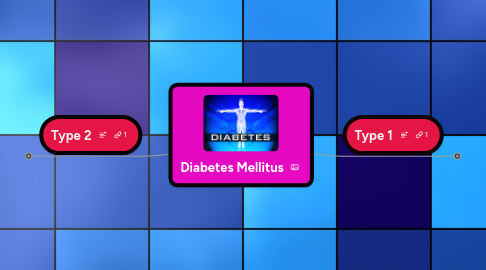
1. Type 1
1.1. Causes
1.1.1. Unknown
1.1.2. Genetics
1.1.3. Autoimmune
1.2. Risk Factors
1.2.1. Family history
1.2.2. Genetics
1.2.3. Environment
1.2.4. Viral exposure
1.2.5. Early vitamin D
1.2.6. Other dietary factors
1.3. Clinical Manifestations
1.3.1. Increased thirst
1.3.2. Frequent urination
1.3.3. Extreme hunger
1.3.4. Weightloss
1.3.5. Fatigue
1.3.6. Blurred Vision
1.3.7. Ketoacidosis
1.4. Diagnostics
1.4.1. Glycated Hemglobin (A1C) Test
1.4.2. Random Blood Sugar Test
1.4.3. Fasting Blood Sugar Test
1.5. Treatments
1.5.1. Monitoring Blood Glucose
1.5.2. Insulin
1.5.3. Diet
1.5.4. Exercise
1.5.5. Secondary Treatments
1.5.5.1. ACE Inhibitors
1.5.5.2. Aspirin
1.5.5.3. Statins
1.6. Nursing Interventions
1.6.1. Monitor blood glucose
1.6.2. Insulin therapy
1.6.3. Manage diet and eating patterns
1.6.4. Monitor intake and output
1.6.5. Determine risk for infection
1.6.6. Check weights daily
1.6.7. Skin care
1.6.8. Patient Teaching
1.6.9. Pyschosocial Support
2. Type 2
2.1. Risk Factors
2.1.1. Age > 45 years old
2.1.2. Obesity
2.1.3. History of gestational diabetes
2.1.4. Family history of type 2 diabetes
2.1.5. Lack of physical activity
2.1.6. Low HDL cholesterol or high triglycerides
2.1.7. Ethnic Background
2.1.7.1. African
2.1.7.2. Latinos
2.1.7.3. Native Americans
2.1.7.4. Asian
2.2. Clinical Manifestations
2.2.1. Fatigue
2.2.2. Hunger
2.2.3. Increased thirst
2.2.4. Increased urination
2.2.5. Blurred vision
2.2.6. Frequent infections
2.2.7. Delayed healing
2.2.8. Long-Term Complications
2.2.8.1. Blindness
2.2.8.2. Feet/Skin infections
2.2.8.3. Myocardial infarction
2.2.8.4. Stroke
2.2.8.5. Kidney disease
2.3. Diagnostics
2.3.1. Fasting Blood Glucose Test
2.3.2. Random Blood Glucose Test
2.3.3. Hemoglobin A1C Test
2.3.4. Oral Glucose Tolerance Test
2.4. Treatments
2.4.1. Managing blood glucose
2.4.2. Physical activity
2.4.3. Oral medications
2.4.4. Insulin
2.5. Lifestyle Management
2.5.1. Reduce stress
2.5.2. Maintain adequate blood pressure
2.5.3. Nutrition
2.5.4. Weight management
2.6. Nursing Interventions
2.6.1. Ambulation
2.6.2. Monitor blood glucose
2.6.3. Dietary interventions
2.6.4. Oral/insulin therapy
2.6.5. Monitor and teach signs of hypo/hyperglycemia
2.6.6. Assess GI distress and sensitivity
2.6.7. Monitor intake/output
2.6.8. Monitor blood values
2.6.9. Monitor daily weights
